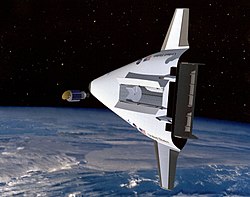One that has an equal or larger payload capability of the space shuttle.
Below from Wikipedia .
Single-stage-to-orbit
Page issues
A single-stage-to-orbit (or SSTO) vehicle reaches orbit from the surface of a body without jettisoning hardware, expending only propellants and fluids. The term usually, but not exclusively, refers to reusable vehicles.[1] No Earth-launched SSTO launch vehicles have ever been constructed. To date, orbital launches have been performed either by multi-stage fully or partially expendable rockets, or by the Space Shuttle, which was multi-stage and partially reusable.
Launch costs for low Earth orbit (LEO) range from $4500 to $8500 per pound of payload ($10,000–$19,000 / kg).[2] Reusable SSTO vehicles offer the promise of reduced launch expenses by eliminating recurring costs associated with hardware replacement inherent in expendable launch systems. However, the nonrecurring costs associated with design, development, research and engineering (DDR&E) of reusable SSTO systems are much higher than expendable systems due to the substantial technical challenges of SSTO.[3]
It is considered to be marginally possible to launch a single stage to orbit spacecraft from Earth. The principal complicating factors for SSTO from Earth are: high orbital velocity of over 7,400 metres per second (27,000 km/h; 17,000 mph); the need to overcome Earth's gravity, especially in the early stages of flight; and flight within Earth's atmosphere, which limits speed in the early stages of flight and influences engine performance. The marginality of SSTO can be seen in the launch of the space shuttle. The orbiter and main tank combination successfully orbits after booster separation from an altitude of 45 kilometres (28 mi) and a speed of 4,828 kilometres per hour (1,341 m/s; 3,000 mph). This is approximately 12% of the gravitational potential energy and just 3% of the kinetic energy needed for orbital velocity (4% of total energy required).
Notable single stage to orbit research spacecraft include Skylon, the DC-X, the Lockheed Martin X-33, and the Roton SSTO. However, despite showing some promise, none of them has come close to achieving orbit yet due to problems with finding the most efficient propulsion system.[1]
Sent from my iPad
No comments:
Post a Comment